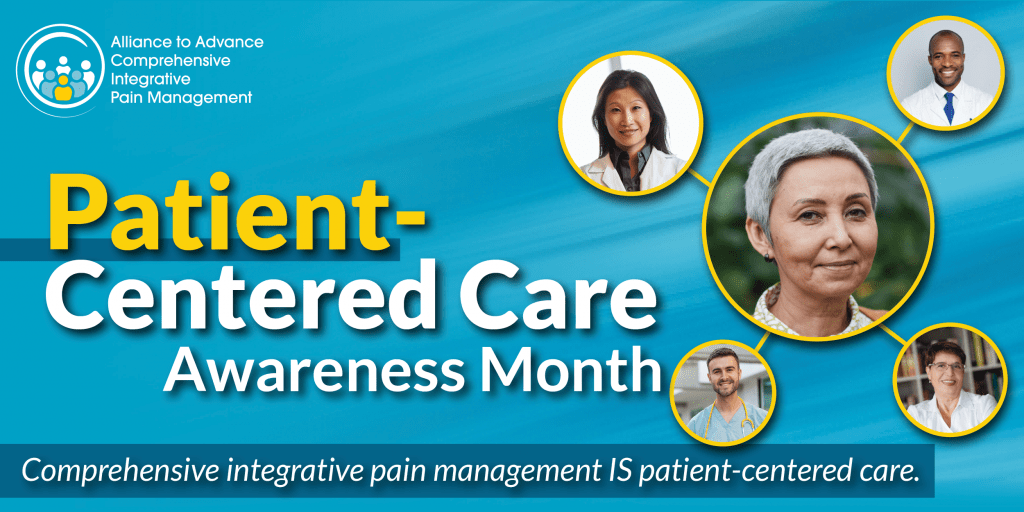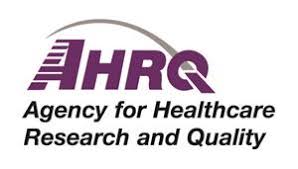October is Patient-Centered Care Awareness Month

October is Patient-Centered Care Awareness Month, bringing with it another reminder about the importance of keeping people with pain at the center of what we do. Comprehensive integrative pain management is, inherently, a whole-person-centered approach to care. This month–and every day–we at AACIPM are committed to tackling the many barriers to achieving universal access to patient-centered comprehensive integrative pain management.
Moving toward “What Matters to You?”
At the core of patient-centered care is asking the patient: What matters to you?
AACIPM and our partners work diligently to promote a paradigm shift that moves toward putting the person with pain, and their goals, at the center of the care plan.
This is foundational to the VA’s Whole Health Initiative across the country. Read more here.
The Center for Practical Bioethics and the American Academy of Family Physicians gave a presentation on patient engagement that was focused on moving the conversation from “What’s the Matter With You?” to “What Matters to You?”
This month, the Whole Health Institute released a curriculum that is about this very topic (read below in Partner Educational Opportunities), offering clinicians a continuing education series to promote skills needed for patient-centered care.
Whole person care translates into different things across the stakeholders, and we at AACIPM remain focused on practical ways to support this paradigm shift. Watch for upcoming impact articles and a revamped repository that will connect more dots and build awareness, as well as tools for patients, providers, payors, purchasers, academia and more.
Spotlight
AccendoWave: Innovative Device that Objectively Measures Pain and Improves Patient Experience Named Quarterfinalist in UCSF Health Awards
 At AACIPM, we welcome and appreciate the insights from all our participants and stakeholders. Synthesizing these insights and tools into a narrative that can be relatable to all of us brings value when promoting patient-centered care.
At AACIPM, we welcome and appreciate the insights from all our participants and stakeholders. Synthesizing these insights and tools into a narrative that can be relatable to all of us brings value when promoting patient-centered care.
This month, Amy Goldstein, Director, AACIPM, spoke with Martha Lawrence, CEO and Co-Founder of AccendoWave, to learn more about their product and recent award.
 AccendoWave is an exciting new system that uses machine learning technology to objectively measure and manage pain. Harnessing active comfort management technology through use of a tablet computer, EEG (electroencephalography) headband, and AccendoWave software, the system has been
AccendoWave is an exciting new system that uses machine learning technology to objectively measure and manage pain. Harnessing active comfort management technology through use of a tablet computer, EEG (electroencephalography) headband, and AccendoWave software, the system has been
shown to reduce pain levels in 83% of patients in a clinical setting.
AACIPM: AccendoWave was recently selected as a Quarterfinalist in the UCSF Heath Awards. Why do you think that UCSF chose to recognize AccendoWave?
Ms. Lawrence: UCSF understood the scope of the problem AccendoWave is solving with pain measurement and pain management and the magnitude of the impact for multiple stakeholders. They also recognized the scale of validation with AccendoWave and real-world evidence of more than 70,000 hospital patients having used the technology. UCSF was also interested in the regulatory roadmap. In August 2021, AccendoWave made a first FDA submission, and the FDA’s Head of Neurology provided the roadmap.
AACIPM: How does AccendoWave measure pain?
Ms. Lawrence: AccendoWave uses deep learning full spectrum brain analysis, using an EEG headband paired with a Samsung tablet. The EEG headband communicates wirelessly with the tablet and is used to objectively measure patient brain waves and then correlates brain waves with the patient’s perception of pain, discomfort, or anxiety. The results are translated into a standard chart of facial expressions, which is displayed on the tablet screen. If patients disagree with the assessment, they can alter the results by selecting a different face. Currently, no other objective pain measurement solution exists, leaving clinical staff and patients attempting to guess the patient’s level of pain.
National Updates
 NIH HEAL Initiative Announces Funding Opportunities Related to Health Equity in Pain Management, Myofascial Pain, and Sickle Cell Disease
NIH HEAL Initiative Announces Funding Opportunities Related to Health Equity in Pain Management, Myofascial Pain, and Sickle Cell Disease
The HEAL Initiative from the National Institutes of Health (NIH) has released information on a number of funding opportunities related to pain management.
HEAL Initiative: Advancing Health Equity in Pain Management is accepting applications for funding, now through December 9, 2021. This funding opportunity seeks to accelerate development, testing and implementation of evidence-based interventions—that are culturally and linguistically appropriate for NIH-designated populations that experience health disparities (HDPs) in the United States—to mitigate disparities in provision of care and treatment decisions, reduce susceptibility to chronic pain and improve patient outcomes.
The HEAL Initiative has also released three Notices of Intent to imminently publish three additional pain-related funding opportunities:
- Pragmatic and Implementation Studies for the Management of Sickle Cell Disease Pain
- Sickle Cell Disease Pain Management Trials Utilizing the Pain Effectiveness Research Network Cooperative Agreement
- Developing Quantitative Imaging and Other Relevant Biomarkers of Myofascial Tissues for Clinical Pain Management
AHRQ Seeks to Fund Research Projects Pertaining to Transitions in Care
 The Agency for Healthcare Research and Quality (AHRQ) is currently accepting applications for large research projects related to ambulatory care settings and long-term care facilities with a focus on implementing evidence-based processes to improve patient safety, especially those involving transitions in care. AHRQ is interested in studies in these two settings that develop, utilize, and evaluate strategies to implement existing measures, metrics, tools or practices that have already been validated and have been shown to be effective in improving patient safety sites.
The Agency for Healthcare Research and Quality (AHRQ) is currently accepting applications for large research projects related to ambulatory care settings and long-term care facilities with a focus on implementing evidence-based processes to improve patient safety, especially those involving transitions in care. AHRQ is interested in studies in these two settings that develop, utilize, and evaluate strategies to implement existing measures, metrics, tools or practices that have already been validated and have been shown to be effective in improving patient safety sites.
Applications are due by January 25, 2022, with letters of Intent due 30 days prior to the application due date.
Board of Pharmacy Specialties Calls for New Specialty in Pain Management
 The Board of Pharmacy Specialties (BPS) is moving forward with further consideration of the creation of a new specialty in Pain Management Pharmacy. The BPS Board of Directors will now determine, in detail, each of the criteria deemed necessary for the creation of a new specialty: need, demand, number/time, specialized knowledge, specialized functions, education and training, and transmission of knowledge. In deciding to pursue creation of this new specialty, the BPS Board of Directors noted an increase in demand of a specific body of knowledge and skills to provide effective pain management services to patients with increasingly complex care needs.
The Board of Pharmacy Specialties (BPS) is moving forward with further consideration of the creation of a new specialty in Pain Management Pharmacy. The BPS Board of Directors will now determine, in detail, each of the criteria deemed necessary for the creation of a new specialty: need, demand, number/time, specialized knowledge, specialized functions, education and training, and transmission of knowledge. In deciding to pursue creation of this new specialty, the BPS Board of Directors noted an increase in demand of a specific body of knowledge and skills to provide effective pain management services to patients with increasingly complex care needs.
FQHCs Prescribe Fewer Opioids Since CDC Guideline, Barriers Impede Use of Alternatives
 A new study of Federally Qualified Health Centers (FQHCs) shows that FQHCs have prescribed fewer opioids to their patients than national and state averages since implementation of the CDC Guideline for Prescribing Opioids for Chronic Pain. However, this report isn’t all good news, as primary care providers (PCPs) report limited time with patients, a lack of training providers in medication-assisted treatment, and provider fear related to opioid prescribing. Further, PCPs at FQHCs report trouble accessing alternatives to opioids for treating chronic pain, citing systemic and patient barriers.
A new study of Federally Qualified Health Centers (FQHCs) shows that FQHCs have prescribed fewer opioids to their patients than national and state averages since implementation of the CDC Guideline for Prescribing Opioids for Chronic Pain. However, this report isn’t all good news, as primary care providers (PCPs) report limited time with patients, a lack of training providers in medication-assisted treatment, and provider fear related to opioid prescribing. Further, PCPs at FQHCs report trouble accessing alternatives to opioids for treating chronic pain, citing systemic and patient barriers.
CMS Releases Annual Update of Medicare and Medicaid Opioid Prescribing Rates
 CMS has released annual updates to its opioid prescribing mapping tools, interactive geographic comparisons of de-identified opioid prescriptions filled within the United States. The mapping tools allow users to see both the number and percentage of opioid prescriptions in the Medicare Part D and Medicaid Programs. The tool further reflects the percentage of a prescriber’s total prescription claims that are opioid prescriptions.
CMS has released annual updates to its opioid prescribing mapping tools, interactive geographic comparisons of de-identified opioid prescriptions filled within the United States. The mapping tools allow users to see both the number and percentage of opioid prescriptions in the Medicare Part D and Medicaid Programs. The tool further reflects the percentage of a prescriber’s total prescription claims that are opioid prescriptions.
 On October 28, U.S. Pain promoted a Virtual Advocacy Day to emphasize the need for access to a full range of multidisciplinary treatments and better coordination of these treatments to tackle chronic pain.
On October 28, U.S. Pain promoted a Virtual Advocacy Day to emphasize the need for access to a full range of multidisciplinary treatments and better coordination of these treatments to tackle chronic pain.
The request is to reach out to your representatives in Congress who are in session right now and request that the Pain Management Task Force (PMTF) Report, which strongly advocates the importance of individualized multidisciplinary care, be disseminated to frontline practitioners across the country. Click on the link below to easily get in touch with your Congressional representatives and advocate for meaningful change.
Partner Educational Opportunities
Whole Health Institute (WHI) has launched a new (FREE) Clinical Foundation Series for providers, clinicians, pre-health students, and health care professionals. The trainings are virtual, experiential, and focus on changing the conversation from “what’s the matter with you?” to “what matters to you?”. There will be a total of eight 4-hour courses in this series, with three of the eight courses currently available. Continuing education credit is available in partnership with the University of Wisconsin-Madison. The trainings are sequential, and registrants can choose to go as far as they like. This series will offer tools to help clinicians develop skills to move beyond the current disease-centered care model toward an approach that equips patients to live full and meaningful lives. You can find additional public offerings offered by WHI here.
Group Medical Visits – Training Available
The Integrated Center for Group Medical Visits (ICGMV) held its inaugural conference in September. This is an important resource for many who are interested in adding to their current training and patient offerings. The session recordings are now available and you can still register here to gain access (CME is only available for the live sessions).
You can also watch the 15-minute keynote by Dr. Wayne Jones here.
Message from the Director
 I hope this issue finds all of you enjoying the fall season. During this month’s activities, I am reminded of the challenging, yet rewarding work, that comes with mission-driven alliance building. Through a number of recent meetings and conversations, I am acutely aware of the positive momentum surrounding all of us – in the form of many roads leading to better value based care options for people with pain.
I hope this issue finds all of you enjoying the fall season. During this month’s activities, I am reminded of the challenging, yet rewarding work, that comes with mission-driven alliance building. Through a number of recent meetings and conversations, I am acutely aware of the positive momentum surrounding all of us – in the form of many roads leading to better value based care options for people with pain.
I am additionally reminded that when working with many stakeholders, it is relatively easy to find the shared interests, but much more difficult to decide what work to do together. I remain motivated in this work because of my belief that our work is spreading bread crumbs, and chipping away at the barriers to whole person centered, multidisciplinary pain care for all.
Trust-building is a foundational and essential element of collective action, and simply takes time. Also, focusing on what any one organization can do is just not enough. Stakeholder alignment is essential and finding the tangible ways to work together – in big or small ways – is what will keep moving this forward.
Onward and Upward!
Amy
Relevant Reading
![]()
Integrative Approaches to Osteoarthritis, Acupuncture Today, November 2021
For Knee Replacement, Physical Therapy Reduces Risk of Chronic Opioid Use, Boston University, October 27
Commentary: How to Correct Course – and Fill the Holes – in the CDC Opioid Prescribing Guideline Revisions, Practical Pain Management, October 26
Can Therapy Help Reduce Back Pain?, Psychology Today, October 24
‘They Treat Me Like I’m Old and Stupid’: Seniors Decry Health Providers’ Age Bias, Kaiser Health Network, October 20
Research reveals troubling implications for female teenagers with obesity and chronic pain, American Physiological Society, October 19
Disabled Gamers Turn Video Games into Self-Care, Forbes, October 13
Reciprocal effects between depressive symptoms and pain in veterans over 50, Pain Medicine, October 13
Effect of physical activity and exercise on endometriosis-associated symptoms: a systematic review, BMC Women’s Health, October 9
Effects of a physical self-care support program for patients with fibromyalgia: A randomized controlled trial, J Back Musculoskelet Rehabil, October 8
Telehealth Increases Access to Brief Behavioral Interventions in Orofacial Pain Clinic during COVID-19 Pandemic: A Retrospective Study, Pain Med, October 8
When Getting Used to Chronic Pain Becomes a Problem, Sickle Cell Disease News, October 8
Management of chronic primary pelvic pain syndromes, BJU International, October 7
Treatment Patterns in Patients with Diagnostic Imaging for Low Back Pain: A Retrospective Observational Study, DovePress, October 7
Can Psychotherapy Treat Chronic Back Pain?, Pain News Network, October 6
Chronic pain treatment should include psychological interventions, Science Daily, October 5
Chronic Pain in Women: A Real Discussion on the Gaps in Care, PPM, October 5
Chronic back pain: Novel mind-body treatment outperforms other therapies, Big Think, October 2
Acupuncture Relieves Opioid-Induced Constipation in Clinical Cancer Therapy – A Meta-Analysis and Systematic Review, DovePress, October 2
Chronic pain in patients with inflammatory bowel disease, PAIN, October 2021
Why Pain Is Not ‘All in Your Head’, Pain News Network, September 30
Effect of Pain Reprocessing Therapy vs Placebo and Usual Care for Patients With Chronic Back Pain: A Randomized Clinical Trial, JAMA Psychiatry, September 29
Stimulating the ear’s pressure points could help treat chronic abdominal pain in children and adolescents, University of Buffalo, September 27
Which symptoms best distinguish fibromyalgia patients from those with other chronic pain disorders?, Wiley Online Library, September 27
Psychophysiologic symptom relief therapy for chronic back pain: a pilot randomized controlled trial, Pain Rep., September 23
Protocol for Testing Yoga to Reduce Post-Lumbar Spine Surgery Pain: A Methodology Article, Int. Journal of Yoga Therapy, July 2021
Feedback
We welcome your input! What do you like? Do you have a contribution for an upcoming newsletter? Send us your comments, suggestions, or contributions.
